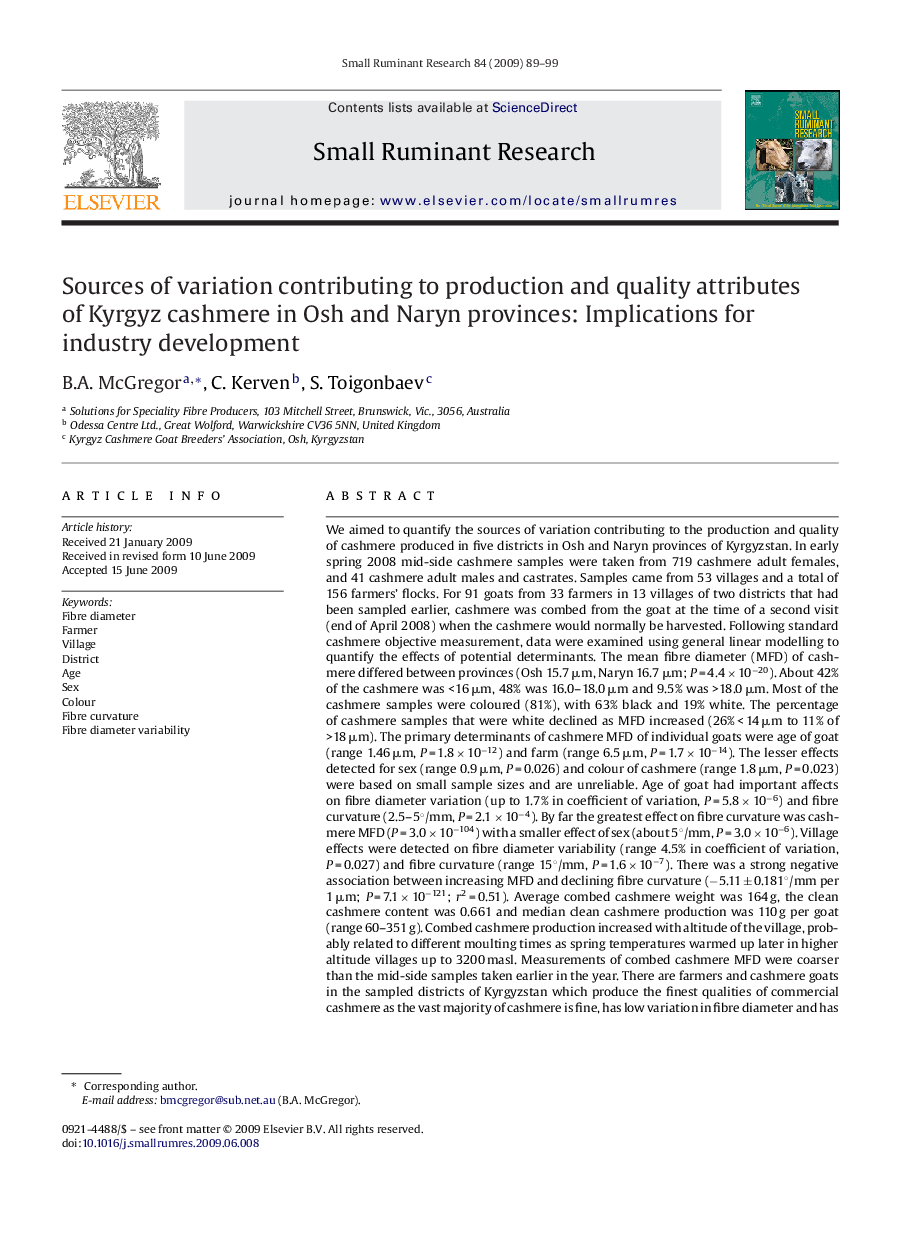| کد مقاله | کد نشریه | سال انتشار | مقاله انگلیسی | نسخه تمام متن |
|---|---|---|---|---|
| 2457766 | 1554408 | 2009 | 11 صفحه PDF | دانلود رایگان |
عنوان انگلیسی مقاله ISI
Sources of variation contributing to production and quality attributes of Kyrgyz cashmere in Osh and Naryn provinces: Implications for industry development
دانلود مقاله + سفارش ترجمه
دانلود مقاله ISI انگلیسی
رایگان برای ایرانیان
کلمات کلیدی
موضوعات مرتبط
علوم زیستی و بیوفناوری
علوم کشاورزی و بیولوژیک
علوم دامی و جانورشناسی
پیش نمایش صفحه اول مقاله

چکیده انگلیسی
We aimed to quantify the sources of variation contributing to the production and quality of cashmere produced in five districts in Osh and Naryn provinces of Kyrgyzstan. In early spring 2008 mid-side cashmere samples were taken from 719 cashmere adult females, and 41 cashmere adult males and castrates. Samples came from 53 villages and a total of 156 farmers' flocks. For 91 goats from 33 farmers in 13 villages of two districts that had been sampled earlier, cashmere was combed from the goat at the time of a second visit (end of April 2008) when the cashmere would normally be harvested. Following standard cashmere objective measurement, data were examined using general linear modelling to quantify the effects of potential determinants. The mean fibre diameter (MFD) of cashmere differed between provinces (Osh 15.7 μm, Naryn 16.7 μm; P = 4.4 Ã 10â20). About 42% of the cashmere was <16 μm, 48% was 16.0-18.0 μm and 9.5% was >18.0 μm. Most of the cashmere samples were coloured (81%), with 63% black and 19% white. The percentage of cashmere samples that were white declined as MFD increased (26% < 14 μm to 11% of >18 μm). The primary determinants of cashmere MFD of individual goats were age of goat (range 1.46 μm, P = 1.8 Ã 10â12) and farm (range 6.5 μm, P = 1.7 Ã 10â14). The lesser effects detected for sex (range 0.9 μm, P = 0.026) and colour of cashmere (range 1.8 μm, P = 0.023) were based on small sample sizes and are unreliable. Age of goat had important affects on fibre diameter variation (up to 1.7% in coefficient of variation, P = 5.8 Ã 10â6) and fibre curvature (2.5-5°/mm, P = 2.1 Ã 10â4). By far the greatest effect on fibre curvature was cashmere MFD (P = 3.0 Ã 10â104) with a smaller effect of sex (about 5°/mm, P = 3.0 Ã 10â6). Village effects were detected on fibre diameter variability (range 4.5% in coefficient of variation, P = 0.027) and fibre curvature (range 15°/mm, P = 1.6 Ã 10â7). There was a strong negative association between increasing MFD and declining fibre curvature (â5.11 ± 0.181°/mm per 1 μm; P = 7.1 Ã 10â121; r2 = 0.51). Average combed cashmere weight was 164 g, the clean cashmere content was 0.661 and median clean cashmere production was 110 g per goat (range 60-351 g). Combed cashmere production increased with altitude of the village, probably related to different moulting times as spring temperatures warmed up later in higher altitude villages up to 3200 masl. Measurements of combed cashmere MFD were coarser than the mid-side samples taken earlier in the year. There are farmers and cashmere goats in the sampled districts of Kyrgyzstan which produce the finest qualities of commercial cashmere as the vast majority of cashmere is fine, has low variation in fibre diameter and has fibre crimping (curvature) typical of Chinese and Mongolian cashmere. There is substantial scope to increase the production and commercial value of cashmere produced by Kyrgyz goats. In particular, some villages and farmers need to change their buck selection practices if they wish to produce acceptable cashmere. Farmers should separate their finer and white cashmere prior to sale.
ناشر
Database: Elsevier - ScienceDirect (ساینس دایرکت)
Journal: Small Ruminant Research - Volume 84, Issues 1â3, June 2009, Pages 89-99
Journal: Small Ruminant Research - Volume 84, Issues 1â3, June 2009, Pages 89-99
نویسندگان
B.A. McGregor, C. Kerven, S. Toigonbaev,